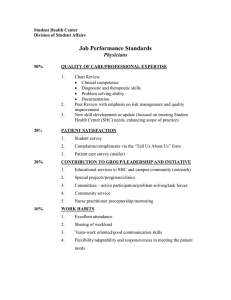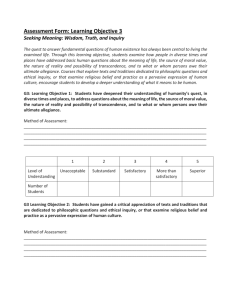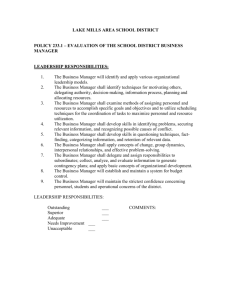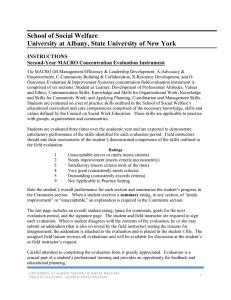Second Year - Clinical, Summer Block
advertisement
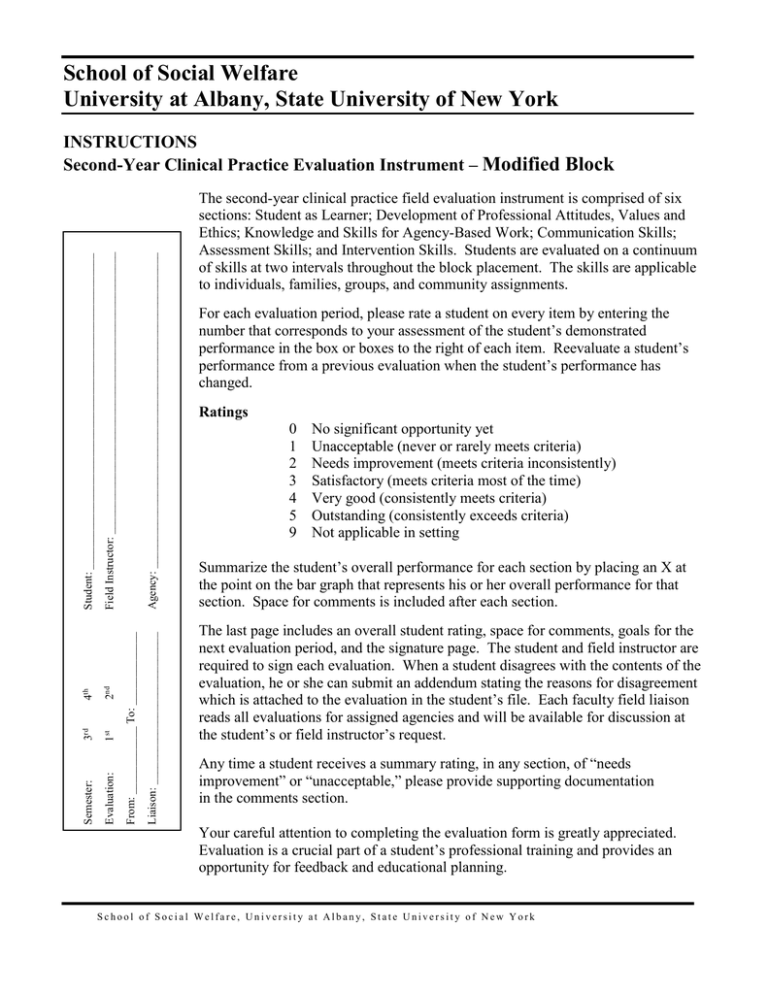
School of Social Welfare University at Albany, State University of New York Liaison: ___________________________ From: ____________ To: _____________ Evaluation: Agency: ________________________________________________________ Field Instructor: __________________________________________________ 2nd st 1 4th Semester: 3rd Student: ________________________________________________________ INSTRUCTIONS Second-Year Clinical Practice Evaluation Instrument – Modified Block The second-year clinical practice field evaluation instrument is comprised of six sections: Student as Learner; Development of Professional Attitudes, Values and Ethics; Knowledge and Skills for Agency-Based Work; Communication Skills; Assessment Skills; and Intervention Skills. Students are evaluated on a continuum of skills at two intervals throughout the block placement. The skills are applicable to individuals, families, groups, and community assignments. For each evaluation period, please rate a student on every item by entering the number that corresponds to your assessment of the student’s demonstrated performance in the box or boxes to the right of each item. Reevaluate a student’s performance from a previous evaluation when the student’s performance has changed. Ratings 0 1 2 3 4 5 9 No significant opportunity yet Unacceptable (never or rarely meets criteria) Needs improvement (meets criteria inconsistently) Satisfactory (meets criteria most of the time) Very good (consistently meets criteria) Outstanding (consistently exceeds criteria) Not applicable in setting Summarize the student’s overall performance for each section by placing an X at the point on the bar graph that represents his or her overall performance for that section. Space for comments is included after each section. The last page includes an overall student rating, space for comments, goals for the next evaluation period, and the signature page. The student and field instructor are required to sign each evaluation. When a student disagrees with the contents of the evaluation, he or she can submit an addendum stating the reasons for disagreement which is attached to the evaluation in the student’s file. Each faculty field liaison reads all evaluations for assigned agencies and will be available for discussion at the student’s or field instructor’s request. Any time a student receives a summary rating, in any section, of “needs improvement” or “unacceptable,” please provide supporting documentation in the comments section. Your careful attention to completing the evaluation form is greatly appreciated. Evaluation is a crucial part of a student’s professional training and provides an opportunity for feedback and educational planning. School of Social Welfare, University at Albany, State University of New York 0 No significant opportunity yet 2 Needs improvement 4 Very good 1 Unacceptable 3 Satisfactory 5 Outstanding 9 Not applicable Describe the student’s assignment for this evaluation period: Describe the student’s caseload: How many individual clients assigned? How many families or groups assigned? How often do you meet for supervision? Weekly In group In staff meeting The Student as Learner The student is able to Jul Aug utilize the field instructor as an educator of social work values, attitudes, knowledge and skills. participate in developing/updating learning agreement. seek and respond nondefensively to feedback about professional performance. seek direction for an assignment, as needed. use constructive criticism to try new skills to improve practice. demonstrate an ability to generalize learning from one case to another. prepare for supervision, including development of an agenda. analyze and verbally articulate her or his own knowledge, skills accomplishments and learning needs. use process recording or other learning tools to critique practice. identify critical points in an interview. analyze interventions analyze client’s and student’s respective roles in the intervention. propose alternative strategies. recognize and initiate steps to work collaboratively with or resolve problems that arise with co-workers. 2 0 No significant opportunity yet 2 Needs improvement 4 Very good 1 Unacceptable 3 Satisfactory 5 Outstanding 9 Not applicable The Student as Learner (continued) Jul The student is able to Aug selectively use the instructor and other agency resources in supervision. be innovative and imaginative in applying knowledge and skill in practice. negotiate and agree on individual tasks and responsibilities for projects or assignments requiring cooperation with co-workers. recognize during supervision personal obstacles to working with a client. Aug demonstrate a capacity for self-directed practice. differentiate his or her effectiveness across areas of practice. identify areas of learning for continuing education and supervision. Summary for Student as Learner (See Instructions) ☐ ☐ ☐ unacceptable needs improvement satisfactory ☐ very good ☐ outstanding Comments: 3 0 No significant opportunity yet 2 Needs improvement 4 Very good 1 Unacceptable 3 Satisfactory 5 Outstanding 9 Not applicable Development of Professional Attitudes, Values and Ethics The student is able to Jul Aug Jul Aug protect client’s right to confidentiality. protect client’s right to self-determination. respect the rights of others to maintain perspectives and positions different from her or his own. act professionally and responsibly in matters of punctuality, appearance, and presentation of self. recognize the impact that the student’s personality has on professional relationships. work with a range of clients and client problems. incorporate social work values and ethics in work with colleagues and clients and in other professional relationships. recognize personal feelings about racism, sexism, homophobia, ageism, client difference and the impact it may have in work with clients. demonstrate good judgment in dealing with value dilemmas. prevent personal biases from interfering with practice decisions in the best interests of the client. Summary for Development of Professional Attitudes, Values and Ethics (See Instructions) ☐ ☐ ☐ ☐ ☐ unacceptable needs improvement satisfactory very good outstanding Comments: 4 0 No significant opportunity yet 2 Needs improvement 4 Very good 1 Unacceptable 3 Satisfactory 5 Outstanding 9 Not applicable Knowledge and Skills for Agency-Based Work The student is able to Jul Aug Jul Aug assess the effect of regulations, policies and procedures on service delivery. identify the range of relevant services (formal and informal) available in the community and the ways in which these services are used for referrals by the field agency. set priorities for use of time and meet deadlines. accept assignments. take responsibility for timely completion of records and statistics and for notifying others of schedules. take an active role in collective work such as team meetings, staff meetings, and committees. describe the procedures followed by agency staff in developing and maintaining cooperative relationships with other agencies in the community. analyze the impact that the agency’s relations with other agencies has on service delivery. conduct oneself in a conscious way in professional relationships. identify the formal and informal channels of communication in the field agency. differentiate between representing a personal, professional or organizational position. identify the formal and informal means by which agency policy is formulated or influenced by internal or external factors. present and defend her or his point of view verbally or in writing. Aug critically examine agency programs and planning and make appropriate suggestions for constructive change. identify ways in which changes in the agency’s relationships with other agencies could affect service delivery. 5 0 No significant opportunity yet 2 Needs improvement 4 Very good 1 Unacceptable 3 Satisfactory 5 Outstanding 9 Not applicable Summary for Knowledge and Skills for Agency-Based Work (See Instructions) ☐ ☐ ☐ ☐ unacceptable needs improvement satisfactory very good ☐ outstanding Comments: Communication Skills The student is able to Jul Aug help clients elaborate on problems. elicit underlying feelings. interpret her or his own agency’s role and function with a client. identify emotionally charged issues. recognize her or his verbal and nonverbal communication of biases and feelings in an interview. control her or his own verbal and nonverbal communication of biases and feelings in an interview. communicate clearly and purposefully in a client group or family setting. maintain focus on client concerns. summarize session content with client. adapt and focus interviewing techniques to the needs of a variety of clients. 6 0 No significant opportunity yet 2 Needs improvement 4 Very good 1 Unacceptable 3 Satisfactory 5 Outstanding 9 Not applicable Communication Skills (continued) The student is able to integrate the elements of the therapeutic relationship as demonstrated by consistent use of the following skills: Jul Aug Jul Aug concern for others acceptance and identification/communication of expectations empathy genuineness appropriate use of authority and power purposeful communication demonstrate active and accurate listening. explore emotionally charged issues. articulate client’s implicit concerns and expectations. identify and address both student and client obstacles to communication (e.g. resistance, student bias, student style). engage client as a partner in the therapeutic process. Aug accurately respond to client’s or group’s full range and intensity of feelings most of the time. Summary for Communication Skills (See Instructions) ☐ ☐ unacceptable needs improvement ☐ satisfactory ☐ very good ☐ outstanding Comments: 7 0 No significant opportunity yet 2 Needs improvement 4 Very good 1 Unacceptable 3 Satisfactory 5 Outstanding 9 Not applicable Assessment Skills The student is able to Jul Aug Jul Aug use different sources of information, including nonverbal data, client’s support system, and collateral contacts in the assessment process. recognize and elicit information that will contribute to the understanding of the client and the client’s situation. identify sources of strengths and stress in the client and in the client’s support system. individualize clients. present this information in a well-written, formal assessment, using agency format and separating facts and inferences. formulate a diagnosis. look beyond the symptom(s) to the underlying problem. identify family system dynamics. assess and understand the individual within the context of the family system. identify client group dynamics. recognize the difference between the needs of an individual and the needs of a client group. integrate knowledge of emotional, biological, social, organizational (including racism, sexism, homophobia, and ageism), economic, and cultural competencies into assessment. integrate theoretical knowledge about normative and pathological human development, individual, family, community, and group structures and processes into assessment. identify when individual client needs and organizational structures or practices are in conflict. apply assessment skills to organizational settings. develop a plan of intervention based on the problem definition. revise the plan based on new information. conceptualize and synthesize knowledge of emotional, biological, social, organizational (including effects of racism, sexism, social class, homophobia, and ageism), economic and cultural components in a critical manner. assess emerging patterns of behavior in a group and identify interventions that facilitate functional group behaviors. 8 0 No significant opportunity yet 2 Needs improvement 4 Very good 1 Unacceptable 3 Satisfactory 5 Outstanding Summary for Assessment Skills (See Instructions) ☐ ☐ ☐ unacceptable needs improvement satisfactory 9 Not applicable ☐ ☐ very good outstanding Comments: Intervention Skills The student is able to Jul Aug set priorities in plans for intervention. use theoretical and practice knowledge in determining goals. base goals on assessment conclusions. use goals to develop interventions. incorporate use of self in intervention skills. identify immediate, short-term and long-range goals. keep goal planning within constraints of agency function. develop focused, realistic interventions within the client system. identify and implement appropriate tasks for the student, client system, and collateral contacts. model, rehearse and impart coping and interactional skills to clients. use strategies that recognize client strengths and empower individuals, families and groups. articulate and utilize recurring themes from session to session. use her or his knowledge of group dynamics to help clients build a positive group culture. 9 0 No significant opportunity yet 2 Needs improvement 4 Very good 1 Unacceptable 3 Satisfactory 5 Outstanding 9 Not applicable Intervention Skills (continued) The student is able to Jul Aug Jul Aug identify obstacles, as they arise, in implementing the contract with clients and groups. seek cooperation from relevant agencies to meet client needs. utilize services from relevant agencies to meet client needs. respond to crisis situations. demonstrate skills in interdisciplinary teamwork. demonstrate skills in case management. actively participate in case conferences. understand and incorporate a range of interventions in a family setting. understand and incorporate a range of interventions in a group setting. engage in differential treatment planning and distinguish between treatment models. deal with client/group resistance about seeking help. deal with anger and conflict with client/group in the therapeutic relationship. demonstrate a specialized knowledge base relevant to specific problems and clients. demonstrate development of crisis intervention skills. demonstrate skills in advocacy, brokerage and linkage. monitor the implementation plan (analyze consequence of change, modify objectives and tasks as indicated, assess new problems that require action). develop a plan to increase the likelihood of maintenance of change. Aug use more than one method of data collection for research and evaluation results to modify practice. utilize evaluation results to modify practice. determine when to terminate intervention. anticipate and deal with a range of client/group and student reactions to termination. evaluate, with the client or group, the extent to which the objectives of the intervention plan were achieved. engage client or group in a review of accomplishments and areas of continuing concern. 10 0 No significant opportunity yet 2 Needs improvement 4 Very good 1 Unacceptable 3 Satisfactory 5 Outstanding 9 Not applicable Summary for Intervention Skills (See Instructions) ☐ ☐ unacceptable needs improvement ☐ satisfactory ☐ very good ☐ outstanding Comments: Overall Student Rating ☐ ☐ unacceptable needs improvement ☐ satisfactory ☐ very good ☐ outstanding Comments: 11 0 No significant opportunity yet 2 Needs improvement 4 Very good 1 Unacceptable 3 Satisfactory 5 Outstanding 9 Not applicable Goals for Next Evaluation Period: Would you like to talk to the faculty liaison regarding this student’s field experience? ☐ ☐ Yes Yes ☐ ☐ No, unnecessary at this time No My field liaison made an attempt to contact me this year. (via email, voice mail, phone conversation or in-person contact) Instructor’s signature Date Would you like to talk to your faculty liaison regarding your field experience at this time? ☐ ☐ Yes Yes ☐ ☐ No, unnecessary at this time No My field liaison made an attempt to contact me this year. (via email, voice mail, phone conversation or in-person contact) I have read the contents of this evaluation. Student’s signature Date PROCESS RECORDING Required: Reminder- Attach a current process recording on which your field instructor has made feedback comments, while being sure to protect client confidentiality. 12


